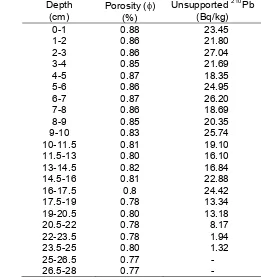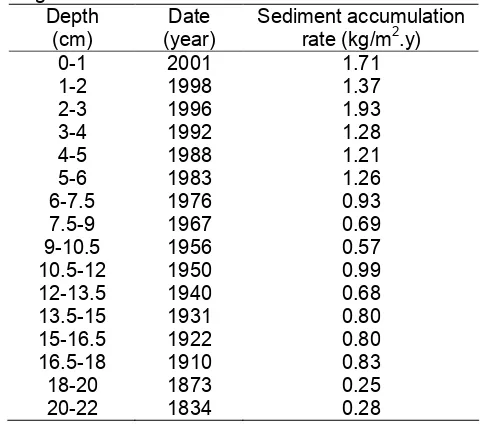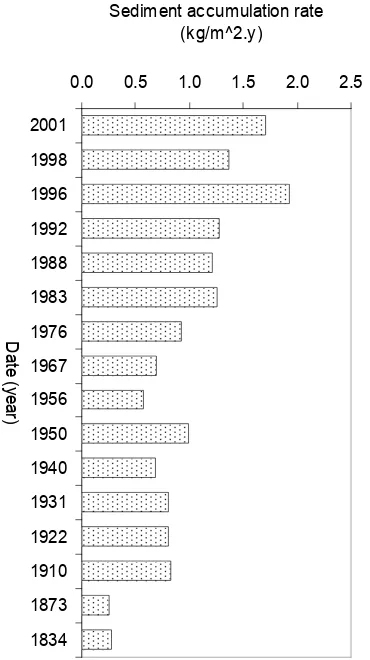* Corresponding author.
Email address : [email protected]
PRELIMINARY STUDY OF SEDIMENT AGES AND ACCUMULATION RATES IN JAKARTA
BAY DERIVED FROM DEPTH PROFILES OF UNSUPPORTED
210Pb
Ali Arman Lubis
*, and Barokah Aliyanta
Center for the Application of Isotopes and Radiation Technology, BATAN Jl Cinere Pasar Jumat, Jakarta 12070
Received 11 August 2006; Accepted 2 October 2006
ABSTRACT
Preliminary study of sediment ages and accumulation rates has been carried out in Jakarta Bay using unsupported 210Pb.210Pb occurs naturally in sediments as one of the radioisotopes in the 238U decay series. The total 210Pb activity in sediments has two components, namely; supported and unsupported. The latter derives from dissociation of 210Pb from226Ra through diffusion of the intermediate gaseous isotope 222Rn which diffuse into the atmosphere and decay to 210Pb. 210Pb falling directly into seawater and deposit on the bed of the marine with sediments.210Pb has half-life of 22.26 years makes it well suited to dating and determining the accumulation rate of sediments laid down over the past 100 – 150 years. Two cores samples with diameter 7.5 cm were taken by scuba divers from Jakarta Bay and were analyzed of 210Pb using -spectrometer equipped with PIPS detector. The sediment ages and range of sediment accumulation rates of core I and II are up to 169 years and (0.25 – 1.93) kg/m2y and up to 157 years and (0.15 – 2.68) kg/m2y, respectively.
Keywords:sediment ages, accumulation rates, marine sediment,210Pb.
INTRODUCTION
In tracing of the history of man’s effect on the environment it is evident in many places the period of greatest impact lies within the last 150 years. Lake and estuarine sediments provide a basis for reconstructing many aspects of this impact, for estimating rates of change and for establishing a baseline in environmental monitoring programs. In such studies the establishment of accurate dating of sedimentation as well as chronologies is of vital importance not only for dating events but also for determining sediment accumulation rates.
Several radionuclides can be used as tracers of various marine processes, including sedimentation. The natural radionuclide210Pb is one of the238U decay series (Fig 1), has physical half-life of 22.26 years and decays to210Bi by beta emission. It is present in the atmosphere as a result of the decaying series of events.226Ra in the earth’s crust decays to the rare earth 222Rn, which diffuse into atmosphere. 222Rn decays via a series short half-lived daughters to 210Pb. 210Pb is removed from the atmosphere by precipitation and a range of residence times have been reported between 9.6 days and a few weeks[1,2].
210
Pb enters and is continuously introduced into the marine environment from, (i) the atmosphere, after decay from222Rn exhaled from the continental crust with short residence time in the atmosphere and is referred to as unsupported 210Pb, and (ii) within the water column, mainly through the radioactive decay of dissolved226Ra, which is normally assumed to be in equilibrium with
226
Ra, is referred to as supported 210Pb[2,3,4]. Because of its reactivity, it rapidly becomes associated with
suspended matter and, therefore, subject to sedimentation. After deposited, it can be used as a tool for determination sedimentation rate over 100-150 years due to it half-life 22.26 years. The distribution of
210
Pb in the sediment profile reflects the depositional history, e.g., regular deposition, periods of non-deposition or erosion, mixing by bioturbation, changes in the deposition rate and change in the sediment source.
In this study, the ages and accumulation rate are determined from the depth profiles of unsupported
210
Pb of marine sediment. The samples from Jakarta Bay are analyzed in order to comprehend this technique. Moreover, this method in using natural radionuclide210Pb for determining of marine process is firstly developed in the Center for the Application of Isotopes and Radiation Technology, National Nuclear Energy Agency, Indonesia.
EXPERIMENTAL SECTION
In order to elucidate in determining of sediment ages and accumulation rates in marine sediment, two sediment cores were used which were collected by diver in May 2003 from eastern part of Jakarta Bay
in collaborating with Research Center for Oceanography, Indonesian Institute of Sciences. Sediment cores were collected from the water depth of 10 m and 15 m and the length are 30 cm and 28 cm, respectively. In the laboratory, cores were sectioned at 1, 1.5 and 2 cm intervals from top to bottom and sections stored in sealed plastic bags. About half of each section was homogenized for210Pb analyses and the remaining was used for heavy metals analyses. Wet and dry masses were determined before and after drying samples at 600C, and dry bulk density were calculated. Sediment porosity was determined from water content, assuming a mineral density of 2.5 g.cm-3[3,4,5].210Pb analyses were performed according to the methodology described by Ballestra [6]. Briefly 3 g of dried homogenized sediment was spiked with209Po tracer for the determination of the chemical yield. A mixture of concentrated hydrogen chloride, nitric acid and aqua-regia was used to digest the sample. The remaining sample was filtered and ascorbic acid was added to complex any iron present.
209
Po and210Po in solution was plated onto a nickel disc for 3 hours at room temperature while stirring. Polonium isotopes (total) were counted with α-spectrometer equipped with PIPS detector (Canberra model A450-20AM) with the resolution 20 keV.210Pb was assumed to be in radioactive equilibrium with 210Po in the sediment samples. Supported 210Pb was determined from 226Ra which is assumed in equilibrating between them, 226Ra was analyzed using -spectrometer equipped with coaxial HPGe detector (Canberra model 2010) relative
Table 1. Porosity and activity of unsupported 210Pb in coring I from Jakarta Bay.
Depth
efficiency 10 % and resolution 2.3 keV in the energy
60
Co 1332 keV. Samples from top, middle and bottom cores were sealed for approximately 4 weeks to achieve equilibrium with it daughter of210Pb [3].
RESULT AND DISCUSSION
The sediment in both cores from Jakarta Bay comprised mainly fine grained silt and clay minerals with the silt + clay contents higher than 90%. The cores appeared homogeneous, with no visible stratification. The relationship between porosity () and depth in core I and Core II are shown in Table 1 and Table 2, respectively. The value ofin core I was 0.86% which found in the surface as indicated the highest value and decreased with depth to 0.77% at 28-30 cm. Similarly, core II has the value ofwas 0.88% in the surface and 0.77% at 26.5-28 cm. These trends indicated the increasing in compaction from the surface to the bottom along both sediment cores.
The activity of supported 210Pb from top, middle and bottom of sediment cores which was assumed in equilibration with 226Ra were relatively constant with depth. The activity of supported 210Pb in core I and Core II was 11 Bq/kg and 16 Bq/kg, respectively.226Ra decays to form from the gaseous 222Rn, which in turn decays via a series of short-lived daughters to form
210
Pb (Fig. 1) [7,8,9]. On the other hand, the activity of unsupported210Pb which was determined from the
Table 2. Porosity and activity of unsupported 210Pb in coring II from Jakarta Bay.
differences between total 210Pb and supported 210Pb indicate decreased from top to the bottom with the maximum activity at the layer 1-2 cm (30.74 Bq/kg) and 2-3 cm (27.04 Bq/kg) for core I and core II, respectively. The unsupported210Pb levels in core I varied from 30.74 Bq/kg to 0.08 Bq/kg and in core II ranged from 27.04 Bq/kg to 1.32 Bq/kg (Table 1 and Table 2). Moreover, the activity of unsupported 210Pb on the surface of sediment is constant, and is usually interpreted as being caused by sediment mixing on time scales that are short compared with the 210Pb half-life (Krisnaswami et. al. and Koide et. al.) [7,10]. Mixing in this layer may be due to disturbance from waves or currents, or to the activity of invertebrates such as heart urchins which plough through the surface layer of sediment mixing components to a depth of about 2 cm (Bird et al,) [7,8,11,12].
The activity of unsupported210Pb with depth in core I and core II are not decrease exponentially; as a result, the sedimentation rates are not constant with the time. Due to this circumstance, the sediment age and accumulation rate are determined by using Constant Rate of Supply (CRS) model [8,9,10,11]. Calculations were made by:
where Ad is the unsupported 210
Pb in the core below depth d, Aois the entire unsupported
210
Pb below water
Table 3. Sediment ages and accumulation rate of coring I. years and t is time (date).
The varying sediment accumulation rate r can be calculated from
where Cdis the unsupported 210
Pb concentration. The inventory of unsupported 210Pb was calculated as the sum of activity of unsupported 210Pb at all depths. These are useful to study sediment accumulation, as inventory is independent of model interpretation. Total Inventory along sediment cores for core I was 1508 Bq/m2 and core II was 1927 Bq/m2, these values will be discussed below in relating to the sediment accumulation rates [6,14,15].
0.0 0.5 1.0 1.5 2.0 2.5
Fig 2. Sediment ages and accumulation rates of coring I of Jakarta Bay.
was slightly constant from 1901 to 1950 and thereafter it increased significantly from 0.78 kg/m2.y to 2.68 kg/m2.y. The significant change in accumulation rates in both cores was caused by the change in the upper catchment of Jakarta Metropolitan area and its vicinity due to urban expansion and land clearing. Moreover, the fluctuation during the last century seems to have some correlations with major floods in recent history. These occurred in every 5 years approximately (in 2001, 1996, 1989) which can be identified in core II (Fig. 2), corresponding to time intervals during which increases in sediment accumulation rates took place [18,19].
Even though the fluctuation of accumulation rates in both cores are quite similar, but the sediment accumulation rates between two sediment cores was different. The average of sediment accumulation rates in core II approximately twice of core I. Non unexpectedly, the inventory in core II was found higher than in core I which related to the highly deposited sediment in the area of core II [6,17].
CONCLUSION
Unsupported210Pb can be used for determining the ages and accumulation rates of marine sediment.
Fig. 3. Sediment ages and accumulation rates of coring II of Jakarta Bay.
model and shows that the sediment ages in two cores are up to 169 years and 157 years on the bottom and the sediment accumulation rates range from 0.25 kg/m2y to 1.93 kg/m2y and 0.15 kg/m2y to 2.68 kg/m2y with the average 0.97 kg/m2.y and 1.56 kg/m2.y, for core I and core II, respectively. Moreover, the sediment accumulation rate on last 50 years increase significantly which may caused by the change on the upper land for construction and housing.
It is suggested to complement this method using artificial isotope 137Cs and other conventional techniques for lacking errors of determination and interpretation.
ACKNOWLEDGEMENT
The authors would like to thank to diving-team of Research Center for Oceanography, LIPI for their help in colleting the samples and Mr. Suripto for his help during the analysis of samples.
REFFERENCES
2. Ivanovich, M. and Harmon, R.S., 1992, Uranium-series Disequilibrium: Applications to Earth, Marine and Environmental Sciences, Clarendon Press-Oxford, 1250-1255.
3. IAEA-TECDOC-1360, 2003, Collection and Preparation of Bottom Sediment Samples for Analysis of Radionuclides and Trace Elements, International Atomic Energy Agency, Vienna., 63-82. 4. Crickmore, M.J., Tazioli, G.S., Appleby, P.G. and
Oldfield, F., 1990,The Use of Nuclear Techniques in Sediment Transport and Sedimentation Problems, International Hydrological Programme, UNESCO, Paris, 131-147.
5. Ballestra, S. and Hamilton, T., 1994, Basic Procedures Manual Radiochemistry, IAEA-Marine Environment Laboratory, Monaco, 75-79.
6. Sanchez-Cabeza, J.A., Masque, P., Ani-Ragolta, I., Merino, J., Frignani, M., Alvisi, F., Palanques, A. and Puig, P., 1999, Progr. in Oceanography, 44, 313-332.
7. Hancock, G.J. and Hunter, J.R., 1999, Marine Freshwater Res.,50, 533-545.
8. Theng, T.L., Ahmad, Z. and Mohamed, C.A.R., 2003,J. Radioanal. & Nucl. Chem.,256, I, 115-120. 9. Carroll, J., Lerche, I., Abraham, J.D. and Cisar, D.J.,
1999,App. Rad. & Isotopes,50, 793-804.
10. Santschi, P.H., Presley, B.J., Wade, T.L., Garcia-Romero, B. and Baskaran, M., 2001, Marine Freshwater Res.,52, 51-79.
11. Gelen, A., Soto, J., Gomez, J. and Diaz, O, 2004, J. Radioanal. & Nucl. Chem., 261, 2, 437-441. 12. Gelen, A., Diaz, O., Simon, M.J., Herrera, E., Soto,
J., Gomez, J., Rodenas, J., Beltran, J. and Ramirez, M., 2003, J. Radioanal. & Nucl. Chem., 256, 3, 561-564.
13. Carroll, J., Williamson, M., Lerche, I., Karabanov, E. and Williams, D.F., 1999, A App. Rad. & Isotopes,50, 1105-1119.
14. Ueda, S., Ohtsuka, Y., Kondo, K. and Inaba, J., 2005, J. Radioanal. & Nucl. Chem., 264, 2, 343-349.
15. Larizzatti, F.E, Favaro, D.I.T., Moreira, S.R.D., Mazzilli, B.P. and Piovano, E.L., 2001, J. Radioanal. & Nucl. Chem.,249, 1, 263-268.
16. Saito, R.T., Figueira, R.C.L., Tessler, M.G. and Cunha, I.I.L., 2001, J. Radioanal. & Nucl. Chem., 250, 1, 109-115.
17. Palanques, A., Sanchez-Cabeza, J.A., Masque, P. and Leon, L., 1998,Marine Chem.,61, 209-217. 18. Soehoed, A.R., 2002, Banjir Ibukota, Tinjauan
Historis dan Pandangan ke Depan, Djambatan, Jakarta, 1-24.



